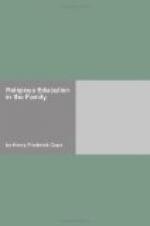Sec. 1. PAST CUSTOMS
But the fact today is that family worship is so rare as to be counted phenomenal wherever found. The instances, though not general, were common a generation ago. Many are living to whom family worship afforded the largest part of their conscious and formal religious education. Following the morning meal, or, occasionally, the evening meal, the family waited while the father, or the mother in his absence, read a portion of the Scriptures and offered prayer. In other families the act of worship would be the closing one of the day, perhaps participated in by the older members only, the younger children having repeated their prayers at bedside on retiring. A thousand happy and sacred associations gather about the memories of these occasions: the sense of reverence, the feeling that the home was a sacred place, the impression of noble words and elevating thoughts, the reflex influence of the prayer that committed all to the keeping and guidance of God.[24]
Sec. 2. WHY FAMILY WORSHIP?
Parents need to see the values in family worship. We have been insisting on the primary importance of the religious interpretation of the family as an institution, on the power of the religious motive, and the atmosphere of religion. But wherever there is a truly religious motive and a permanent religious atmosphere these will find definite expression in acts easily recognized as religious. Love is the motive and atmosphere of the true home, but love blossoms into words and bears fruit in a thousand deeds. The life of love dies without reality in act. Ideals are precipitated in expressive acts. So is it with religion in the home; it must not only be real in its sincerity, it must be realized, must pass over into conduct and action, as suggested above in chaps. vii and viii. And it must do this in ways so sharply defined and readily recognized as to leave no doubt as to their meaning. True, all acts may be religious and thus full of worship—this is most important of all—but worship expressly unites all such acts in a spirit of loyalty and aspiration.




